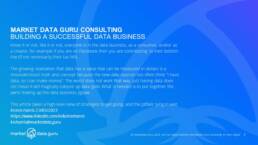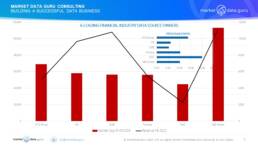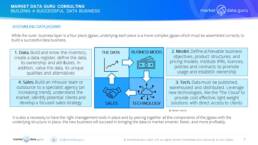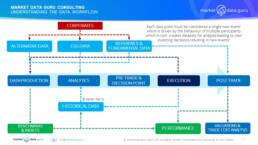

DATA PITFALLS, SO DIG IN THE RIGHT PLACE
For data source owners looking to monetise their data to generate revenue, (and for some companies the value of their data is worth more than the underlying business) a coherent approach is required to mitigate the errors that many have already made, for instance:
Many new data sources have little to no expertise or experience in creating a data business, often they think just because they have data, there is a market for it. This is a false assumption, A business strategy needs to be identified, pricing model developed, transparent and easily understood policies created. Expertise is required.
Data Sources must invest in developing a business models, harnessing technologies, building partnerships, and generating sales. There is a cost involved, but it need not be exorbitant or prohibitive. What works for one data source owner will not always work for another even if they are in the same market, exchanges are a case in point. Resources are required
Concepts such as Intellectual Property Rights (IPRs) are the beating heart of the data business, but often misunderstood or inadequately addressed. New ways to use data usage always precedes new ways to charge for it and so data’s incredible versatility which makes data so valuable is also an Achilles Heel. We call this the ‘Snickers Effect’. Establishing ownership and rights is an absolute requirement.
DATA GOLD RUSH
Data is the new Gold Rush, and unlike, say, the old Klondike and Witwatersrand rushes, there is no need to dig deep to find the data.
However, in this market ‘First Mover Advantage’ is critical to success because data embedded within clients becomes incredibly ‘sticky’, so once ingested it is hard to remove or displace, so builds stable and continuous revenue flows. This places an emphasis on the new business to be flexible with the ability to develop effective business models, areas putative data sources are notoriously weak in.
Businesses built upon Intellectual Property Rights (IPRs) provide high margins, low risk. Owning and controlling data has proven and measurable value. Moody’s, MSCI, and S&P Global’s businesses are built around their own IP, Exchanges, for instance, CME, ICE and LSEG originally driven by the data created by trading on their venues which has been enhanced through value added services like analytics.
PERSPECTIVE
- The 6 businesses highlighted had combined 2022 revenues of $39,387 Million
- On 31 March 2023 their market capitalisation totalled $315,482 Million
- The average Price/Sales Ratio was 8.01
- Alternative Data Market will be worth $135,724 Million by 2030 with CAGR of 52% according to Grand View Research (08/02/2023)
- ESG Data Market growing at 20% PA with start up firms having a share of 33% estimates ESG Clarity with ESG linked AUM to hit $53 Trillion by 2025

THE LICENCE MODEL
The building block ‘gold nugget’ is the licence model that allows the exact same data to be ‘sold’ multiple times for multiple purposes, producing the magic trick that the revenue potential of a single data item is technically infinite.
There is a warning, in fact four, without addressing these basic criteria a data business will NOT succeed:
1.Having unique quality datasets, understanding their intrinsic value, and how consumers will make money from it
2.Data in demand: Wanted is Alternative Data, Commercial Data and OTC Markets Data (Bonds, Energy, Commodities)
3.Attributes: Data must have Accuracy, Consistency, Timeliness, with access to historical databases
4.Ability to leverage new technologies and distribution mechanisms to reduce reliance upon traditional data flows, open new marketplaces utilising business flexibilities coming into existence
STRIKING DATA GOLD
Starting a data business does not need ‘Rocket Science’, what it requires are four simple things:
1.Commitment to establishing and then building the business
2.Creating the data environment from getting to know your data, building the business model around the data, leveraging technology to get your data to your clients, and selling (licensing) the data
3.Provide the resources to achieve success
4.Have in place the operational tools to manage the business
The diagram below develops these themes.

PARTNERSHIPS ARE POSITIVES
What is understated is the degree to which partnerships are a necessity and how beneficial they can be to building success. Data is a collaborative game, no company does it all, or on their own. Partners provide reach, knowledge, experience, expertise, technology and tools.
At the initial stages, especially creating the data assets, and business models, consultants (Shameless plug-such as us at Market Data Guru) provide expertise and experience, and have already learnt the lessons from their mistakes
Data sources are not technology companies, there is often the mistaken view they are the same thing. Wrong! Once this has been realised technology partners and new channels to market become enablers and facilitators that then act as ‘force multipliers’. These do not have to be the large ‘brands’ as there are innovators in publishing, distribution, and accessibility, like Activ Financial, Arcontech, and BCCI.
Even the largest existing data sources, such as the big stock exchanges, can lack global presence, so partnerships can even extend to sales, again there are ground breakers such as EOSE and USAM.
A forgotten point of failure is lacking the right tools to administer, report, and invoice for the business, so service offerings like DataBP at the source end, or MDSL and TRG Screen on the client side are operational imperatives.
UNDERSTANDING THE DATA WORKFLOW
The final element is understanding what happens to the data on its journey from creation to usage because at each point the data is being used for multiple purposes and in different ways.
The greater the emphasis on models and analytics as the tools to drive investing generates the requirement for more data to propagate them because it improves the accuracy of the outputs.
The diagram below summarises in a simplified format how data fits into the decision process in financial markets trading flow, which shows linear as well as cyclical properties, especially as the realisation grows that historic data takes an increasingly higher place in the data value hierarchy. It also reflects the roles played by Reference, Alternative Data and ESG Data, much of which comes from corporations.

SUMMARY
Data businesses can produce higher margins than the process which created the data in the first place, though of course without the ‘events’ there is no data business. Based on our consulting work with exchanges and inter-dealer brokers data usage proactively drives business back to the data source allowing a virtuous circle to develop. In itself this is a strong reason to build a successful data business.
To summarise the core foundation stones of the business we need to:
1.Understand and properly value the data owned
2.Create a business positive environment that encourages data utilisation, after all the data consumers are subscribing because they want the data to make money themselves. This must never be forgotten
3.Know the clients, why and how they use the data. This is all about following the workflows and where your data fits into the process, and it is constantly changing
4.Realise in financial markets and other industries adding value to the data via analytics, benchmarks, and other ways not only increases the margins on the data, it expands the client base and generates higher revenue.
In today’s world, not matter what the business or industry, future success is being driven by decisions based on the extraction of an increasing amount of data.
Gaining a competitive edge is about maximising value as either the supplier or the consumer.
Keiren Harris 23 May 2023
For our information on our consulting services please visit www.marketdata.guru/data-compliance
To contact us knharris@marketdata.guru
Please contact info@marketdata.guru for a pdf copy of the article


